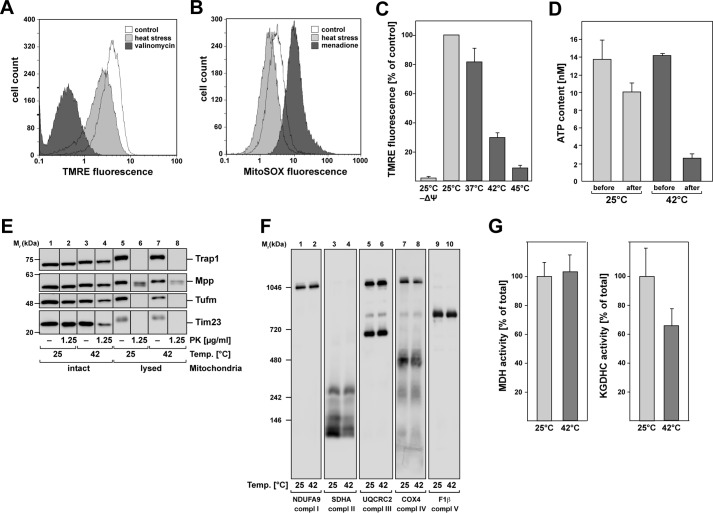Figure 1.
General effects of heat stress on mitochondria. A and B, flow cytometry analysis of HeLa cells after heat stress. A, analysis of mitochondrial membrane potential by TMRE staining. Black, negative control (valinomycin treatment); white, control at 37 °C; gray, heat stress at 45 °C for 2.5 h. B, detection of reactive oxygen species using the mitochondria-specific superoxide-reactive dye MitoSOXTM. Black, positive control (menadione-treatment); white, control at 37 °C; gray, heat stress at 45 °C for 2.5 h. The results shown are representative of two independent experiments. C, membrane potential of isolated mitochondria after 20 min of incubation at different temperatures. The potential was measured by TMRE fluorescence in a microplate reader. Shown are the means of the relative values of the respective sample compared with the control sample at 25 °C (n = 3) and S.E. D, ATP content in isolated mitochondria after heat shock. The ATP concentration was determined as described under “Experimental procedures” either directly before or after 20 min of incubation at 25 or 42 °C. E, integrity of mitochondria after heat stress. Incubation of isolated HeLa WT mitochondria at 25 and 42 °C for 20 min and following 20 min of treatment with PK at the indicated concentrations. Mitochondria were lysed prior the treatment with buffer containing 0.5% Triton X-100 as control for a sufficient PK treatment. F, analysis of the mitochondrial protein complexes in isolated mitochondria after heat stress (20 min, 42 °C) compared with unstressed conditions (20 min, 25 °C). Mitochondria were analyzed by blue native PAGE or SDS–PAGE and Western blotting. Antibodies against subunits of complex I (NDUFA9), complex II (SDHA), complex III (UQCRC2), complex IV (COX4), and complex V (F1β) were used. G, enzymatic activity assays of mitochondrial enzymes after heat shock. Activities of MDH and KGDHC were measured as described after incubation of isolated mitochondria for 20 min at 25 and 42 °C. The values shown are means ± S.E. of the ratio of the activity after heat stress compared with control conditions.

